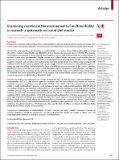Files in this item
Examining variation in the measurement of multimorbidity in research : a systematic review of 566 studies
Item metadata
| dc.contributor.author | Ho, Iris Szu-Szu | |
| dc.contributor.author | Azcoaga-Lorenzo, Amaya | |
| dc.contributor.author | Akbari, Ashley | |
| dc.contributor.author | Black, Corri | |
| dc.contributor.author | Davies, Jim | |
| dc.contributor.author | Hodgins, Peter | |
| dc.contributor.author | Khunti, Kamlesh | |
| dc.contributor.author | Kadam, Umesh | |
| dc.contributor.author | Lyons, Ronan A | |
| dc.contributor.author | McCowan, Colin | |
| dc.contributor.author | Mercer, Stewart | |
| dc.contributor.author | Nirantharakumar, Krishnarajah | |
| dc.contributor.author | Guthrie, Bruce | |
| dc.date.accessioned | 2021-08-10T16:30:03Z | |
| dc.date.available | 2021-08-10T16:30:03Z | |
| dc.date.issued | 2021-08 | |
| dc.identifier | 274105161 | |
| dc.identifier | bd62bfd5-17ae-4526-a1d5-47882ce00e81 | |
| dc.identifier | 85111306551 | |
| dc.identifier | 000680269500013 | |
| dc.identifier.citation | Ho , I S-S , Azcoaga-Lorenzo , A , Akbari , A , Black , C , Davies , J , Hodgins , P , Khunti , K , Kadam , U , Lyons , R A , McCowan , C , Mercer , S , Nirantharakumar , K & Guthrie , B 2021 , ' Examining variation in the measurement of multimorbidity in research : a systematic review of 566 studies ' , The Lancet Public Health , vol. 6 , no. 8 , pp. e587-e597 . https://doi.org/10.1016/S2468-2667(21)00107-9 | en |
| dc.identifier.issn | 2468-2667 | |
| dc.identifier.other | ORCID: /0000-0002-9466-833X/work/96141542 | |
| dc.identifier.other | ORCID: /0000-0003-3307-878X/work/96141555 | |
| dc.identifier.uri | https://hdl.handle.net/10023/23753 | |
| dc.description | Funding: This work was supported by supported by Health Data Research UK (HDR-UK; grant number CFC0110) which receives its funding from the UK Medical Research Council, Engineering and Physical Sciences Research Council, Economic and Social Research Council, Department of Health and Social Care (England), Chief Scientist Office of the Scottish Government Health and Social Care Directorates, Health and Social Care Research and Development Division (Welsh Government), Public Health Agency (Northern Ireland), British Heart Foundation, and the Wellcome Trust. . | en |
| dc.description.abstract | Background A systematic understanding of how multimorbidity has been constructed and measured is unavailable. This review aimed to examine the definition and measurement of multimorbidity in peer-reviewed studies internationally. Methods We systematically reviewed studies on multimorbidity, via a search of nine bibliographic databases (Ovid [PsycINFO, Embase, Global Health, and MEDLINE], Web of Science, the Cochrane Library, CINAHL Plus, Scopus, and ProQuest Dissertations & Theses Global), from inception to Jan 21, 2020. Reference lists and tracked citations of retrieved articles were hand-searched. Eligible studies were full-text articles measuring multimorbidity for any purpose in community, primary care, care home, or hospital populations receiving a non-specialist service. Abstracts, qualitative research, and case series were excluded. Two reviewers independently reviewed the retrieved studies with conflicts resolved by discussion or a third reviewer, and a single researcher extracted data from published papers. To assess our objectives of how multimorbidity has been measured and examine variation in the chronic conditions included (in terms of number and type), we used descriptive analysis (frequencies, cross-tabulation, and negative binomial regression) to summarise the characteristics of multimorbidity studies and measures (study setting, source of morbidity data, study population, primary study purpose, and multimorbidity measure type). This systematic review is registered with PROSPERO, CRD420201724090. Findings 566 studies were included in our review, of which 206 (36·4%) did not report a reference definition for multimorbidity and 73 (12·9%) did not report the conditions their measure included. The number of conditions included in measures ranged from two to 285 (median 17 [IQR 11–23). 452 (79·9%) studies reported types of condition within a single multimorbidity measure; most included at least one cardiovascular condition (441 [97·6%] of 452 studies), metabolic and endocrine condition (440 [97·3%]), respiratory condition (422 [93·4%]), musculoskeletal condition (396 [87·6%]), or mental health condition (355 [78·5%]) in their measure of multimorbidity. Chronic infections (123 [27·2%]), haematological conditions (110 [24·3%]), ear, nose, and throat conditions (107 [23·7%]), skin conditions (70 [15·5%]), oral conditions (19 [4·2%]), and congenital conditions (14 [3·1%]) were uncommonly included. Only eight individual conditions were included by more than half of studies in the multimorbidity measure used (diabetes, stroke, cancer, chronic obstructive pulmonary disease, hypertension, coronary heart disease, chronic kidney disease, and heart failure), with individual mental health conditions under-represented. Of the 566 studies, 419 were rated to be of moderate risk of bias, 107 of high risk of bias, and 40 of low risk of bias according to the Effective Public Health Practice Project quality assessment tool. Interpretation Measurement of multimorbidity is poorly reported and highly variable. Consistent reporting of measure definitions should be required by journals, and consensus studies are needed to define core and study-dependent conditions to include in measures of multimorbidity. Funding Health Data Research UK. | |
| dc.format.extent | 11 | |
| dc.format.extent | 884324 | |
| dc.language.iso | eng | |
| dc.relation.ispartof | The Lancet Public Health | en |
| dc.subject | RA0421 Public health. Hygiene. Preventive Medicine | en |
| dc.subject | 3rd-DAS | en |
| dc.subject | SDG 3 - Good Health and Well-being | en |
| dc.subject.lcc | RA0421 | en |
| dc.title | Examining variation in the measurement of multimorbidity in research : a systematic review of 566 studies | en |
| dc.type | Journal item | en |
| dc.contributor.institution | University of St Andrews. School of Medicine | en |
| dc.contributor.institution | University of St Andrews. Population and Behavioural Science Division | en |
| dc.contributor.institution | University of St Andrews. Sir James Mackenzie Institute for Early Diagnosis | en |
| dc.identifier.doi | https://doi.org/10.1016/S2468-2667(21)00107-9 | |
| dc.description.status | Peer reviewed | en |
This item appears in the following Collection(s)
Items in the St Andrews Research Repository are protected by copyright, with all rights reserved, unless otherwise indicated.

